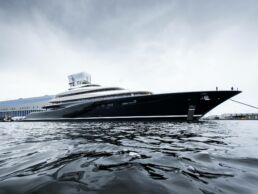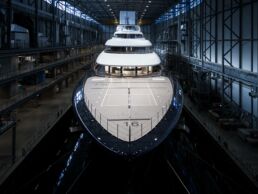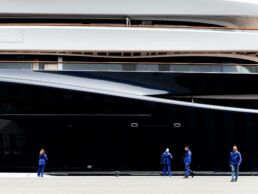Feaship introduced the globe's initial hydrogen fuel cell high-end yacht, Motor yacht USHER, also known as Project 821 - a significant move towards creating more eco-friendly superyachting experiences.
Crafted by RWD and with the backing of Edmiston, Feadship’s daring approach involved a comprehensive, diesel-free strategy aimed at cruising between ports or docking spots, powering the yacht’s guest facilities and comforts with emission-free energy from green hydrogen. “Our goal is to create a new, eco-friendly technology not just for this project but for the global market,” stated Jan-Bart Verkuyl, CEO of Royal Van Lent Shipyard. The large size of the envisioned yacht – over 100 meters – made it an ideal candidate for testing pure green hydrogen as its energy source. For those fascinated by the latest technological breakthroughs, this yacht offers a chance at acquisition, highlighting the highest point of contemporary technological achievements.
Feadship’s research and development team has been exploring hydrogen and other environmentally friendly alternatives to fossil fuels as part of the company’s commitment to creating “net zero” yachts by 2030. Hydrogen fuel cells, a clean method of producing electricity without combustion, emit only water vapor. Although hydrogen fuel cell-powered vehicles exist, and fuel cells have been the primary source of electrical power for space travel for over 60 years, there was no such technology in the maritime industry. The lack of hydrogen storage and fuel-cell system regulations at the class, flag state, or international naval organization level posed a challenge. To overcome this, Feadship, Edmiston, and Lloyd’s Register collaborated to create the necessary equipment, protocols, and safety standards in a coordinated effort.

One of the principal challenges involved in this endeavor is developing an effective method for storing compressed liquid hydrogen at temperatures as low as -253°C below deck on a luxury yacht. However, investing in the requisite technology to transition away from fossil fuels is imperative, with hydrogen emerging as one of the most efficient and environmentally friendly alternatives. The process of converting hydrogen into fuel within a fuel cell generates only electricity and water vapor as by-products.
Hydrogen possesses a significant advantage in terms of weight; a cubic meter of liquid hydrogen is approximately 70 kilograms, in stark contrast to the weight of some 800 kilograms per cubic meter for non-fossil diesel equivalents such as HVO or e-diesel. Nonetheless, the safe storage of hydrogen on a vessel necessitates the utilization of a double-walled cryogenic storage tank, which is essentially a large, highly insulated cooling box housed in a specialized room. This arrangement requires eight to ten times more space for hydrogen storage than diesel fuel’s equivalent energy content.
In summary, the combination of the cryogenic fuel tank capable of holding 92 cubic meters (approximately 4 tonnes) of hydrogen, the sixteen compact fuel cells, their connection to the DC electrical grid through a switchboard, and the vent stacks for the discharge of water vapor, collectively, extend the original specifications of the yacht by four meters. Notably, the fuel cells developed for Project 821 can also utilize methanol, a liquid fuel that can be stored at ambient temperatures. The process involves the conversion of steam back into methanol before the electrochemical reaction within the fuel cell.

Even a massive yacht like Project 821 falls short of carrying sufficient liquid hydrogen to fuel a journey. Still, Feadship has found a way to significantly reduce a yacht’s environmental impact at its most significant location by generating electricity to meet the hotel’s energy needs. The Yacht Environmental Transparency Index (YETI) reveals that 70-78 percent of a yacht’s annual energy consumption is dedicated to powering its hotel facilities, with heating and cooling being the primary uses. The environmental benefits are immediate and substantial, as can be seen by utilizing non-polluting hydrogen fuel cells to generate this electricity. For extended voyages or without pure hydrogen, the yacht’s 3,200 kW ABB pod is powered by MTU generators that use HVO, a biofuel variant that cuts emissions by 90 percent. This approach was successfully demonstrated on the 2023 Feadship Obsidian.
While large battery banks are increasingly seen as a reliable method for powering generators without noise during quiet nights at anchor or for cruising in marine protected areas that do not allow discharges, Project 821’s storage capacity for batteries is modest, holding only 543 kW hours, in comparison to the first diesel-electric hybrid, the 83.50-meter Savannah, launched in 2015, which boasted a megawatt of electrical storage. Project 821, however, does not rely on batteries. Its fuel cell technology can provide a week’s worth of silent operation at anchor or cruising at 10 knots without emissions, making it ideal for docking in harbors or navigating in marine protected areas.
Additionally, Project 821 boasts the most advanced waste heat recovery system ever created, which efficiently heats the pool, Jacuzzi, steam room, and even the ambient air in guest bathrooms, as well as towel bars and floors. The yacht also benefits from a Smart AC system that connects sensors to an energy management system, automatically adjusting the air conditioning or heating in unoccupied guest areas. This leads to further energy savings in the hotel load.

Project 821 boasts numerous accolades, including being the largest motor yacht ever launched in the Netherlands, narrowly surpassing the recently completed 118.00-meter LAUNCHPAD for the flagship title. Despite their nearly identical launch agreements, Project 821 contains 30% more space. With five decks above the waterline and two beneath, and even before her sleek mast is attached, her stature is impressive – for instance, the owners’ deck stands at 37 meters above sea level – yet her design is both sleek and contemporary. She also features the most hull openings among any Feadship, including fourteen sliding balconies from the deck space, five large shell doors, and seven expansive platforms, all offering a striking connection to the ocean. These balconies are discreet when closed but can be extended, revealing their side railings or walls. Upon full extension, their floors align perfectly with the interior living space.
Designed for a family lifestyle, the complete owners’ deck above the bridge is essentially a living space with two bedrooms, twin bathrooms, dressing rooms, a gym, a pantry, and two offices, each with a fireplace and a living room. The full walkaround deck, featuring shaded areas forward and aft, offers beautiful spots for dining and relaxing in the forward jacuzzi.
The spacious 19-meter beam allows for wide hallways and elegant side decks outside, where guests can stroll side-by-side.
However, the living quarters for the owner extend beyond a single deck. A unique and entirely private vertical corridor stretches down to the lower deck. This corridor includes a spacious staircase adorned with bookshelves, display areas, and an owners’ elevator. There are inviting private spaces at each deck level, such as a coffee corner and games area on the bridge deck, a library on the main deck, and a private dining room with a sea terrace and an ensuite stateroom on the lower deck. These spaces create a secluded four-level home-like setting by the sea within the larger yacht.
SHARING IS CARING - THANK YOU!
About Publisher
 Ahoy, I’m René, the “captain” of this luxury yacht blog, and found my passion for the big ones at the age of 17. I have grown up with sailing since a little child. I have an education in Business Informatics and specialized in digital media solutions (alongside luxury yachts) like Online-Marketing, User Experience Design et cetera. My home port is in Oldenburg, Germany next to Lürssen and Abeking & Rasmussen. More about yachtemoceans
Ahoy, I’m René, the “captain” of this luxury yacht blog, and found my passion for the big ones at the age of 17. I have grown up with sailing since a little child. I have an education in Business Informatics and specialized in digital media solutions (alongside luxury yachts) like Online-Marketing, User Experience Design et cetera. My home port is in Oldenburg, Germany next to Lürssen and Abeking & Rasmussen. More about yachtemoceans